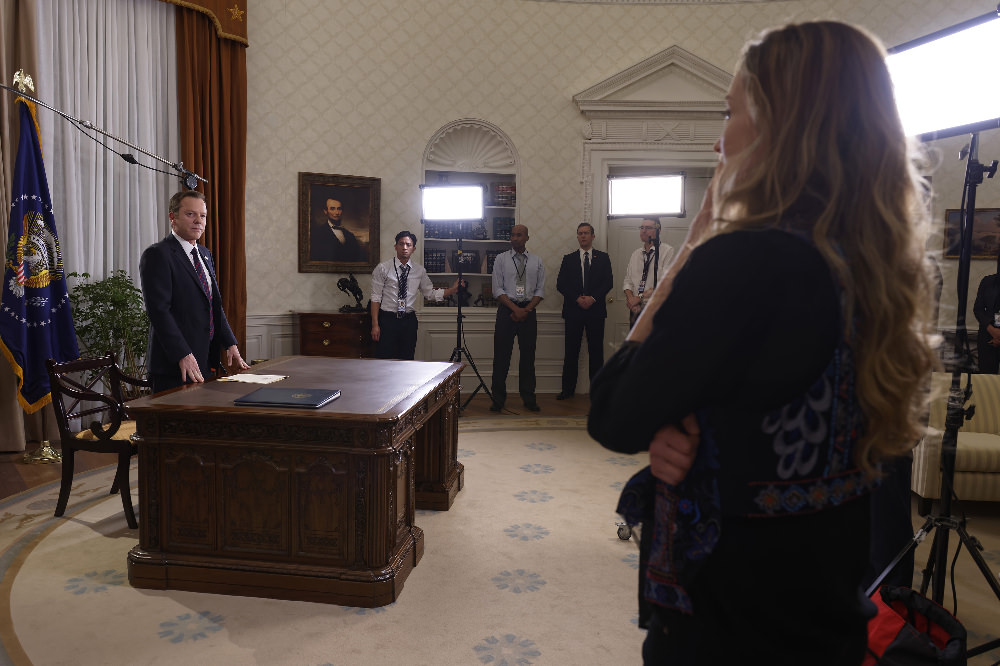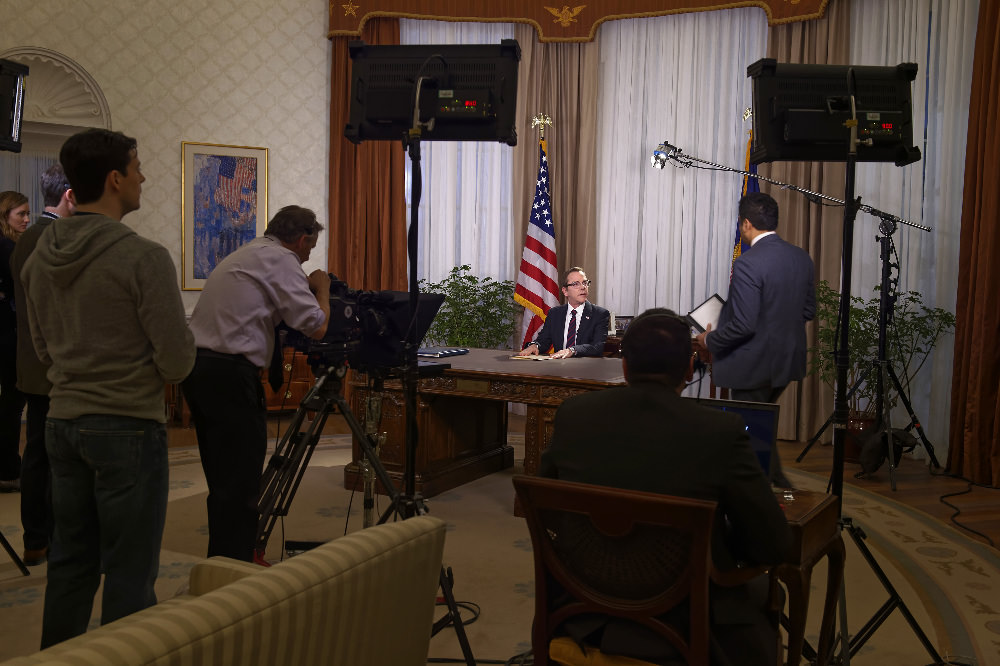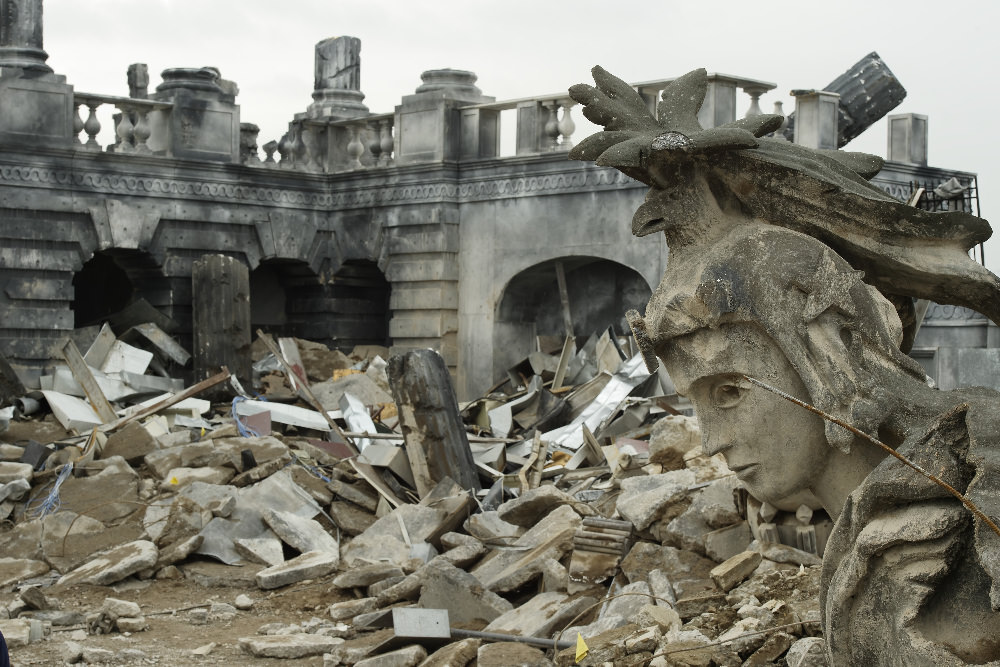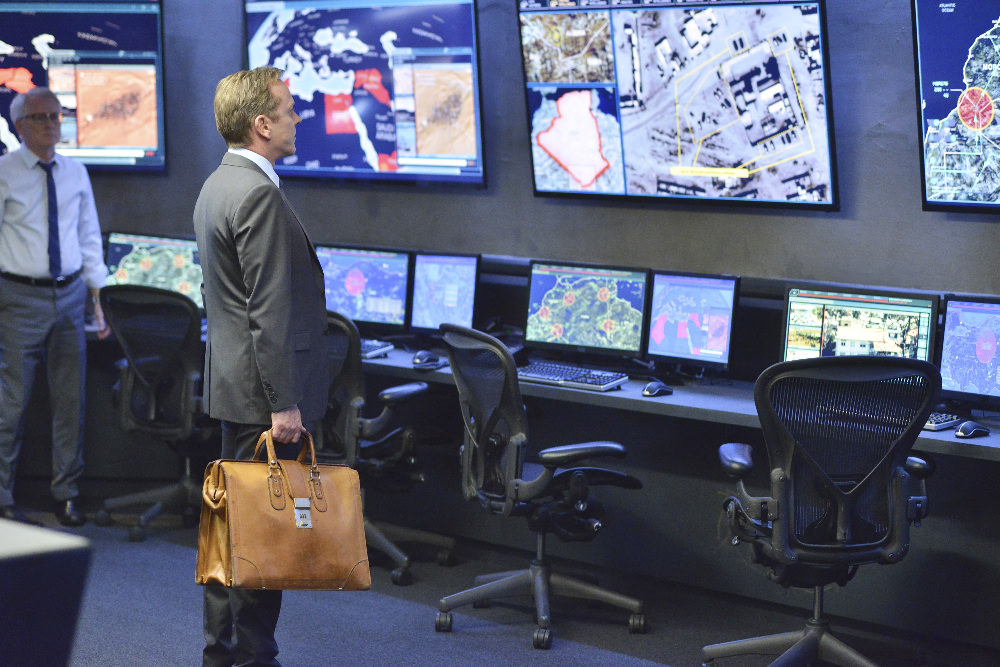Designated Survivor‘s Production Designer on Creating a Dystopian D.C.
Production designer Cabot McMullen has created the settings for television series from Saturday Night Live to Scrubs, Smash, and Cougar Town. Before the audience hears a line of dialog, sometimes before they even see a character, McMullen has to let us know immediately what world we are in. That is not just identifying the story as gritty reality or heightened humor or fantasy; he shows us who the characters are by letting us know how they create their home and workspaces.
For Designated Survivor, with Kiefer Sutherland as a cabinet secretary who unexpectedly becomes President when all of the top officials of the US government are killed in a terrorist attack, McMullen had an especially daunting challenge. He had to create a replica of one of the most iconic spaces in the world, the Oval Office in the West Wing of the White House. In an interview, he talked about being allowed to visit the real Oval Office as part of his research, and about being inspired by Stanley Kubrick in creating the big “wow” moment.
https://www.youtube.com/watch?v=N_f1v0Nx5Sw
You visited President Obama’s office?
Yes, we actually had a private tour during our research phase. We are very fortunate to have Rich Klein as a consultant on the show. There were several specific locations written in the script and we really wanted to try to get a sense of what the White House and what Washington DC was like during 9/11. And so Rich set up meetings for us with the Metro DC Police, the Secret Service, and the FBI, and then on one of our visits we got into the West Wing for a private tour. I think there were five of us that were allowed in. It was about 9:30 at night. President Obama was in Los Angeles at the time, so it was pretty quiet but it was great because we got to really wander around and look at all the details. We got to go into the Oval Office. We were not allowed to take pictures but I had a sketchpad and I was sketching furiously as we were walking through. I couldn’t help but notice all the pre-Civil War stuff with the height of the doors and the way they handled ventilation and the hardware, a lot of it was nautically inspired.

Kiefer Sutherland and Natascha Mcelhone. (ABC/Ben Mark Holzberg)
We had done our homework; we had really researched the Oval Office in particular but also the West Wing. I was looking for details in the décor. Obama brought in Michael Smith as the decorator and it was a first time that I’ve noticed that they put patterns on the walls. They had stripes and in previous administrations it was mostly sort of monochromatic, shades of white, off-white which doesn’t really show the geometry of the room very well but with stripes in there you really get a sense of the overall geometry and so that was something that we used in our version.
The highlight of the tour for me was when we walked down to the Rose Garden. It was night so we couldn’t see very much but the young man who was giving us the tour started waving to somebody in the shadows out on the lawn. It turned out that he was walking Obama’s dog so we got to have a little playtime with the dog, which was fun.
What else influenced you in your research?
During JFK’s administration Jackie brought in a French decorator and he had just finished a renovation of the Oval Office for president Kennedy on the day that he was killed and so when LBJ inherited that and walked into that office he was walking into JFK’s décor. We had a very similar situation in our show where President Richmond is lost in the bombing and then Kirkman steps in as the new president and so it was a very similar kind of set up historically for us.
And I also started referencing Roosevelt because the drapes in our office are almost taken right from Roosevelt, kind of imperial with the eagle medallions on them. And then the flag motifs were inspired by Nixon’s Oval Office and the color palette and the decor itself we pretty much took from Reagan, which was layers of creams and earth tones, all very kind of tasteful and not very colorful. We skipped over Clinton and we got some clues that we took from Obama’s White House as well so it is a bit of a mash-up but really there are great elements from all administrations.

Kiefer Sutherland. (ABC/Ben Mark Holzberg)
Another interesting part of the story is that when we asked all the experts what DC looked like on 9/11. Most of them said, “Well you know the one really iconic visual marker that we all remember was that the sky turned red. “ We were like, “What do you mean that the sky turned red?” and they said, “At every intersection DC Metro put flares down so that the security, all the motorcades, could fly through uninterrupted. All the red flares at the intersections created this sort of red glow all over the part of town where the mall is and the White House.” In the pilot, when the motorcade is whisking him to the White House all those flares in the road those are all inspired by what they told us.
Will we see President Kirkman put some of his own touches into the office over time?
That’s right. It was pretty much determined that when Kirkman walked into Richman’s Oval Office there would be a level of respect and that he would let things sort of be for a while.
The thing about production design is that it’s really a visual language. It’s a subtext and it’s really intended to tell you things about the characters that the script can’t tell you with words. We are the visual backstories. So there are touches in the Richman office to do with his family, to do with his politics, to do with his interest in history and all that. We had to make all that stuff up because it wasn’t in the script.
And some of the sets were virtual or digital?
Yes, the Capitol, I would say it was one third physical and two thirds virtual. So we built a physical bombed out version of one corner of the House of Representatives, the exterior portico and we trucked in real rubber from a construction site. It was a massive set that was put together very quickly and that became sort of the foreground for all the destruction behind it. When you see Capitol dome decimated and the fire and smoke and everything, that’s all virtual.

The bombed out Capitol. (ABC/Ben Mark Holzberg)
Very few Americans have been in the Oval Office, but we have all seen it depicted in dozens of television shows and movies. How do you balance the expectations of the viewers but also keep it new and interesting?
One of the things that we realize with the 24-7 news cycle and with shows like Veep, Scandal, Madam Secretary, everyone in the world knows these rooms quite well. They are so iconic. If there’s anything that’s really not honest or out of place, it’s going to be the thread that could unravel everything else. So we went to Washington several times and we were really determined to be as accurate as we could within reason for the spaces that everybody would recognize. We took a fair amount of license with the rest of the layout of the West Wing primarily for camera just so it could travel through this hallway.
We picked up kind of iconic little touchstones so you could connect the dots. For example the little anteroom that’s outside of the main door of the Oval Office, we got that as accurate as we could. Their views across the hall too, like the Roosevelt room, it’s all a little more open so you can actually look into the room. Walking around we really got a sense of the geography and what we could get away with.
What did you have to change for the purposes of filming?
The critical part in the pilot was that as Tom Kirkman ventures in the White House for the first time, Paul McGuigan, our director, wanted to have like little stolen glances of staff members on their phones, watching the TV, taking in the news and really sort of absorbing the shock of the thing. And so we created openings in the hallway and in some cases we had doorways with leaded glass in them so that as you peered through you get a sort of refraction of light and the image would be somewhat distorted but that was really the goal, to create a very intense walk for Kirkland as he comes out of the car, goes into the building for the first time and sort of takes in the gravity of it all and then ends up in that spot just outside the Oval Office to be sworn in.
Are there any special challenges or benefits to shooting in an oval shaped room as opposed to the rectangular shape that everybody is used to?
Technically it is difficult to build; everything is on a radius. The floor pattern that we put into the wood floors is taken from Ronald Reagan’s Oval Office. He had done a renovation I think before he took over and he put in sort of like a herringbone of light and medium toned wood. The oval shape of the room really presented us with a mathematical challenge to have to get all that patterning correct so it resolved itself correctly at the apex of the room. We build the room exactly to dimension. We did a lot of research between archival, architectural drafting that we found from some of the archives, from some of the renovations that had been done over the years. We also looked at a lot of films that had been done in the past, so we got some drafting from those mostly just to kind of double check and to validate the work that we were doing. So the room I think is one of the most accurate in film and television right now.
Designated Survivor combines all the things that I’m most interested in between art, architecture, and history. And we get to make things up, too. If you look at show’s PEOC, which is the President’s Emergency Operations Center that was a bit of fantasy and fiction. We did meet with the security people from DC and they couldn’t tell us a lot about it because so much of it is classified but there is a crisis center underneath the White House, it’s about eight stories down, you take an elevator down, it connects to tunnels that go all the way out to the Washington monument. And a lot of the structure started during World War II during Roosevelt era. So there’s a lot of construction going on behind the scenes that the public really doesn’t have access to. And so we were able to gather all that information and then abstract it a bit. Mark Gordon wanted that set to be a kind of a big “wow” moment in the show, he wanted it to be a big production set, so I started to looking to Stanley Kubrick particularly Dr. Strangelove and his fantastic War Room, the Ken Adams design.

(ABC/Ben Mark Holzberg)
In Designated Survivor, the very first scene takes place in a safe room of the FBI building and behind Kirkman is a wallpaper pattern that I developed that was inspired by David Hicks. He did the famous carpet in The Shining and so Designated Survivor opens with a Kubrick reference and then ends with a Kubrick reference because you have the War Room at the end and then the wallpaper at the beginning so it’s a kind of little chestnut that we put in there.
Paul, our director, had a very specific image in mind for that room. It opens the show, it opens the story, and it’s really critical to everything. He wanted to create something that was very rooted in the Cold War era. We referenced a bunker called the Diefenbunker. That’s where the Canadian government goes if there is ever an issue or event. And there were some rooms in there that seem to just perfect for us but of course we couldn’t shoot there. We looked all over Toronto trying to find something similar and we just couldn’t come up with it. So literally like a week before we shot we built that set and it is one of my favorites. I love the way it came out and how it kicks everything off.
Featured image: Kiefer Sutherland in Designated Survivor. (ABC/Ben Mark Holzberg)


